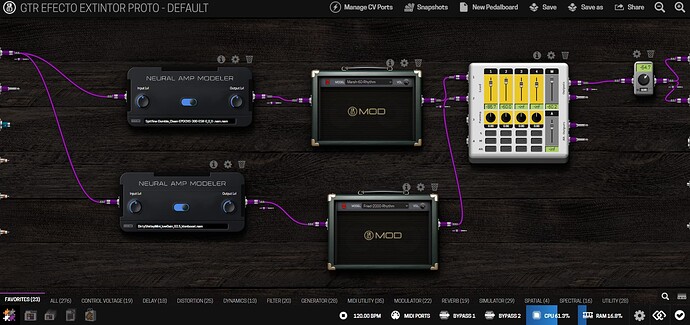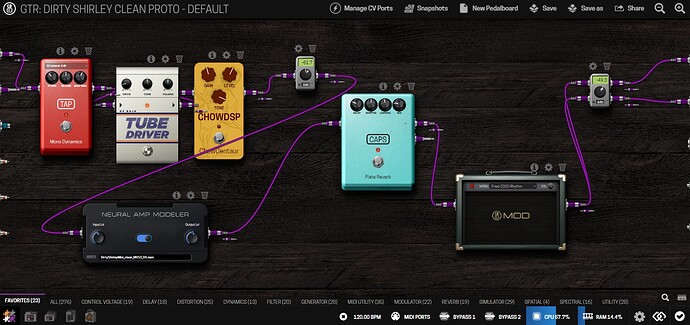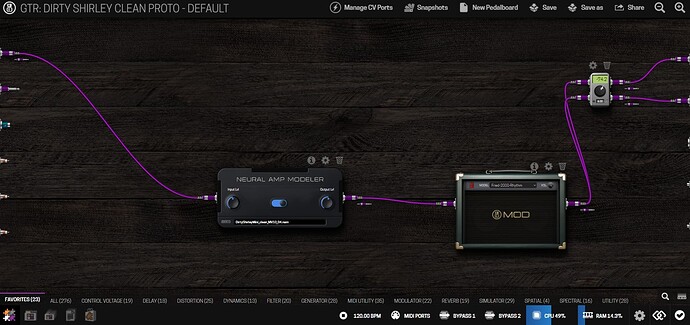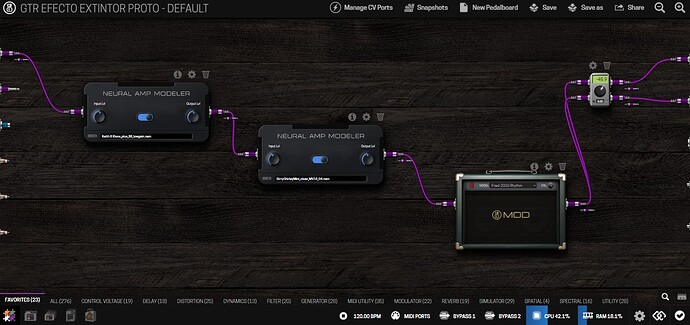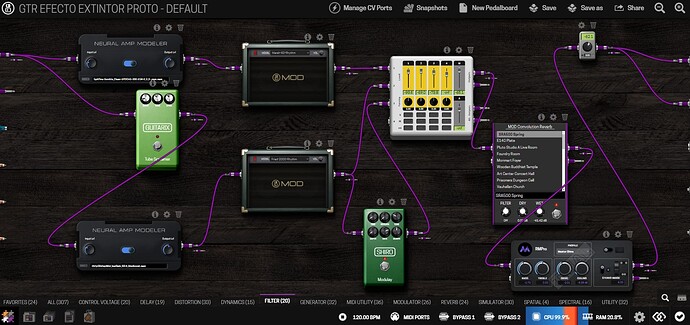@spunktsch well, there are a lot of reasons to use MOD Software, it has all the plugins in one place, most of them sounds really good and I don’t need to find the right plugin myself, I can try different chains with a total patch freedom, it’s compatibile with a touch screen, it can run on linux even without a monitor, it sounds really great, especially using NAM + IR + IR Reverbs, plus, it looks cool and like a real pedalboard, plus it’s open-source, I can contribute eventually and last but not least, it’s free “for now”! Enough? ![]() The only thing I’m missing now is a proper midi support to switch the pedalboards, I didn’t try the Mod-App latest version 0.0.6, but in the commits I didn’t see any modification for that really. It will come, eventually. On the other hand, working with VSTs on Windows gives you the abilityto have very powerful plugins, which are not available for MOD, but you have to cherry pick them one by one, but I don’t like Windows for Audio apps…
The only thing I’m missing now is a proper midi support to switch the pedalboards, I didn’t try the Mod-App latest version 0.0.6, but in the commits I didn’t see any modification for that really. It will come, eventually. On the other hand, working with VSTs on Windows gives you the abilityto have very powerful plugins, which are not available for MOD, but you have to cherry pick them one by one, but I don’t like Windows for Audio apps…
Thanks for the reminder. I just became a patron.
I’m just checking the CPU usage now.
This one has 2 NAM instances and 2 IR cabs (around 60% and stable). When you add plugins or manipulate the pedalboard it can max out for 1 sec or so but it’s usable.
This one with only one NAM instance but a “normal” chain of pedals goes around the same (around 60%).
And this last one is the same as before without the pedals (around 50%).
I’m really happy with the device!! ![]()
If you need more CPU, you could experiment with the Portal plugin, which allows for some parallel processing. Introducing Portal
@Techno that configuration allows JACK to use multiple cores, try to cascade two instances of NAM in serial, like you do with an overdrive and an amp (load a booster pedal in the first one). You’ll see that this way you are going way up, because Jack uses a single core for that chain… could you try that?
I thought the portal was only available for the Dwarf.
Yeah in series it maxes CPU out without even loading a NAM model in the second NAM instance.
I still can double de buffer size and I can barely notice the latency. The CPU usage is now around 43% ![]()
This gave me the chance to try the Klon Centaur and sounds great! ![]()
Yeah increasing the buffer helps a lot, I’m running 64 samples 2 periods with two serialized NAMs, full chain with IR and IR convolution reverb at 30% Dsp ![]() anyway… the Klon captures are sick, try also my Suhr Riot captures
anyway… the Klon captures are sick, try also my Suhr Riot captures ![]() Suhr Riot | ToneHunt
Suhr Riot | ToneHunt
OMG
Unlimited tones lol ![]()
Really nice setup man! ![]()
Also what is JACK? ![]()
@Techno jackd is the audio server used by mod software, mod-host connects to it and it loads each plugin and patches them each other
Not that I need so much CPU hungry stuff on my pedalboard but I was wondering where would be a good place to put the portal plugin in this:
Everywhere I tried it just maxes out the CPU and stays there.
RMPro is quite heavy, so split between reverb and RMPro.
Thanks!! I’ll try that
It didn’t work ![]() . It’s not really important, I’m only experimenting.
. It’s not really important, I’m only experimenting.
From what I understand the Mixer plugin is also CPU hungry. Maybe change that for some Tiny Gain plugins and then reverb into portal into RmPro. Since you are on Mod Duo X you could also experiment using more portals though it might affect latency. However I find that combining parts of pedalboards with 128 with parts that have added latency due to portal sounds great. Especially when the parts with latency are connected to reverb or delays and such! Keep experimenting! It`s amazing what these devices are capable of!
Thanks! Good idea! I’ll try that.
It depends on the use case. I’m trying to build a mixer based on the Duo X and an USB audio interface. I experimented with two different approaches: First, dedicated volume plugins (almost 40 instances) for each bus. Second, cascaded mixers (11 instances) for each bus.
In both scenarios CPU usage was pretty much the same while I even got VU-meters, pan and mute included in the mixers. The only disadvantage is that the usage of the AUX bus in the mixer plugin is muting the signal on main which complicates stuff like send effects. Working on my own fork for that.
